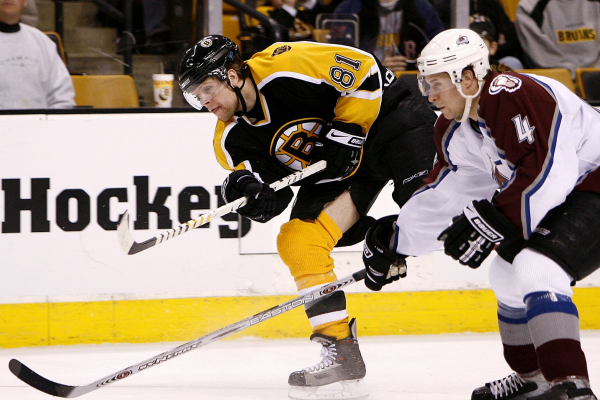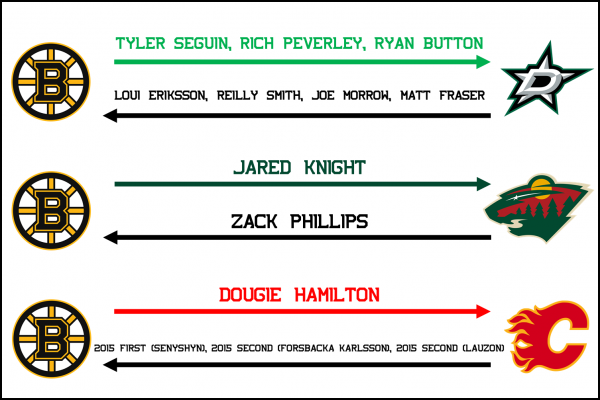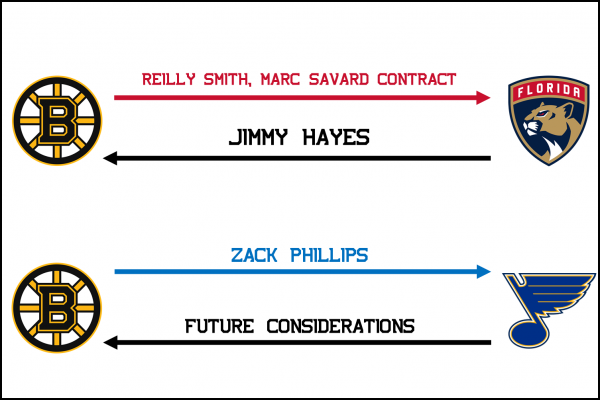
By: Nathan Anderson | Follow me on Twitter @dairybeast
On September 18, 2009, the Boston Bruins and Toronto Maple Leafs shook the hockey world with a blockbuster trade that would go on to have a massive impact on the future of both franchises. Phil Kessel, after scoring 36 goals in the 2008-09 campaign, packed his bags in Boston and was shipped up to Toronto in exchange for first-round picks in 2010 and 2011 and a second-round pick in 2010[1].

At face value, this move seemed to set the Bruins up for a rebuild, bolstering their prospect pool and looking to the future while giving up a promising young talent because he didn’t quite fit the system in Boston. They were just coming off of a shocking Eastern Conference Semi-Final loss to the Carolina Hurricanes and seemed to be trying to revert back to the “Big Bad Bruin” style of play.
As I’m sure most of you reading this article know, those draft picks turned out to be pretty valuable in the coming years, and Phil Kessel didn’t really do much to help the Leafs in terms of championships. Those two first-rounders became Tyler Seguin and Dougie Hamilton, both of whom are elite-level players in the league now. Although neither one of them still show up to work in the home locker room at the TD Garden these days, the initial trade of Phil Kessel to the Toronto Maple Leafs helped the Bruins win the 2011 Stanley Cup and could potentially still help them win another.
Seguin played a key role in that 2011 Stanley Cup run. He wasn’t initially in the starting lineup for most games but got his chance in the Eastern Conference Final when Patrice Bergeron picked up an injury. He scored three times in that series to help the B’s advance past the Lightning to the Cup Final, where they ultimately took down Vancouver.
Once Removed from Kessel
After making two runs to the Stanley Cup in 2011 and 2013, the Bruins decided it was time to move on from their former number-two-overall selection for reasons that never became very clear. Everyone knew it had to do with off-ice issues, though, and I don’t think there were many Bruins fans that were happy about it at the time.
You would expect the return for a player like Seguin, who has become an elite scorer and always showed the promise to do so, to be extremely high. Also thrown into the deal was third-liner Rich Peverley, who was a crucial part of the 2011 championship. The package was sent to the Dallas Stars in exchange for veteran Loui Eriksson, Reilly Smith, Joe Morrow, and Matt Fraser.[1]
I was only 13 at the time, but I do remember liking the acquisition of Loui Eriksson. He was always a good player for the Stars, and he was an established scorer. The other guys I didn’t really know much about, but Joe Morrow and Matt Fraser didn’t ever really pan out to be very useful for the Bruins.
Reilly Smith was a great player in Boston, though. I’m actually not sure what the general fanbase thinks of him, but I have nothing but good opinions of Reilly Smith. He was solid for the Bruins and fit in really well with Patrice Bergeron.
He only played two years for the Bruins and didn’t put up staggering point totals by any means (51 in 2014 and 40 in 2015),[2], but he was solid. He was also the only player in that Seguin trade that the Bruins moved again at a later date, so we’ll come back to him later in this article.
Seguin wasn’t the only player to be traded from that original trade. In fact, no one that the Bruins acquired in that first Kessel trade is still even in the organization. Jared Knight never played a game in the NHL and was traded to the Minnesota Wild for Zack Phillips on March 2, 2015.[1]

Dougie Hamilton, however, became a promising young player for the Bruins. In his time with the Bruins, he played a small role in the 2013 Cup Finals run and had respectable individual seasons in 2014 and 2015. Initially, looking back at his stats combined with Reilly Smith, I thought that ’14 and ’15 were the two rebuilding years for the Bruins.
That actually wasn’t correct, though. The Bruins had an excellent season in 2013-14 that resulted in a President’s Trophy. That may have been part of the problem, however. The Bruins were awesome that season and lost in the second round at the hands of their bitter rivals in Montreal. Following a season like that, fans were expecting something big, and the Bruins did not deliver. The Bruins finished fifth in the Atlantic Division in 2015, and the executives decided it was time for a change.
Twice Removed!
That summer marked the end of Peter Chiarelli’s reign as General Manager, and with it came a fire sale during the summer of 2015. One casualty of that summer was Hamilton, who was shipped out west to Calgary, who sent back a first-round pick and two seconds for the draft later that summer.[1] Those picks ended up being Zachary Senyshyn, Jakob Forsbacka Karlsson, and Jeremy Lauzon. We’ll get to them in a little bit, but right now, I have to circle back to Reilly Smith.
Reilly Smith also got caught up in the fire sale of 2015 after just two seasons in Boston. He was sent down to Florida on July 1 that summer along with Marc Savard’s contract for Jimmy Hayes.[1] Hayes played a couple of seasons with his hometown Bruins during those tough rebuilding seasons in 2016 and 2017 and totaled 34 points in 133 games.[3] Hayes was bought out by the Bruins in the summer of 2017, so that section of the trade tree gets clipped there.
The last trade of this tree is kind of an anticlimactic one because we still don’t really know if it’s active or not. In 2016, Zack Phillips, who as previously mentioned was acquired for Jared Knight, was sent to St. Louis for “future considerations.”[1] Those considerations have seemingly never been followed through on, and the Bruins have done this a couple of times, so I think it’s fair to assume that they just won’t pull the trigger on that. We can call that branch clipped with an asterisk, maybe just in case the Bruins ever call up the Blues in ten years, asking for their promise to be fulfilled.

So now, the only branch left unclipped is the fallout of the Dougie Hamilton trade. I mentioned that the Bruins got Senyshyn, Forsbacka Karlsson, and Lauzon as a return for Hamilton. Until this year, all three of them remained in the Bruins system. Obviously, that changed when Jeremy Lauzon was selected by the Seattle Kraken in this year’s expansion draft.
Apart from Lauzon, though, the other two “prospects” (can we still call them prospects at this point?) are still technically in the Bruins organization. Zachary Senyshyn has gotten a couple of cracks with the big club but has spent most of his professional career in the AHL. Forsbacka Karlsson spent a few years in the United States professionally but moved back to his native Sweden after the 2018-19 season.[4] The Bruins still technically have his NHL rights, but I personally don’t see him returning to the NHL.
Looking Back
So now that we’ve broken down, all the trades, let’s review what it meant for the Bruins. Essentially, the Bruins started out with Phil Kessel and have ended up with Zachary Senyshyn. Along the way, they won a Stanley Cup in 2011 and made it to two others in 2013 and 2019.
Tyler Seguin played a crucial role in the 2011 playoff run even while not being a first-choice player, but other than that, none of the other guys contributed too much to any real success in Boston. Even Dougie Hamilton only played in seven games during the 2013 cup run, and he didn’t have any big moments like Seguin had in 2011. It remains to be seen if Senyshyn can make an impact in the NHL, and maybe he’ll do that this year with the openings in the forward depth chart. The fact is, though, he hasn’t.
Loui Eriksson did a job for the Bruins for a few years, and as I mentioned, Reilly Smith was a decent enough player. What the Bruins had when they drafted Tyler Seguin and Dougie Hamilton was two elite, potentially world-class players who could have been cornerstones in building another championship.
Of course, keeping them around would have drastically changed the course of history, and the Bruins may not have David Pastrnak or Charlie McAvoy. That doesn’t make it any easier to look back and see what they had compared to what it’s become. Would you trade one or both of those superstars if it meant the Bruins had won a championship in 2015 or 2019? I can say personally that I’d have to think long and hard about that.
Ultimately, it’s only a debate now. We’ll never get to see that situation play out, and we can only hope that Senyshyn will come in during the 2022 Stanley Cup Final to score the overtime-winning goal that brings the Cup back to Boston.
[1] https://www.nhltradetracker.com/user/trade_list_by_team/Boston_Bruins/
[2] https://www.hockey-reference.com/players/s/smithre01.html
[3] https://www.hockey-reference.com/players/h/hayesji01.html
[4] https://www.eliteprospects.com/player/115158/jakob-forsbacka-karlsson


Leave a Reply